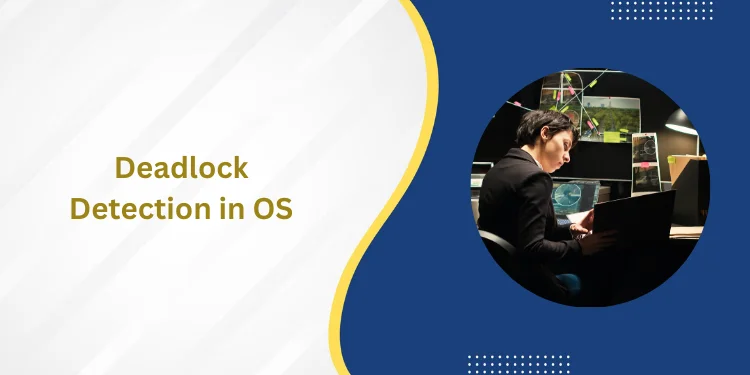Table of Contents
ToggleOverview
When dealing with concurrency control in operating systems, understanding deadlock is essential. Deadlock Detection in OS, As such, deadlock detection is a crucial component of operating system. Deadlock prevention and detection can help to prevent resource starvation as well as potential system crashes or freezes.
Deadlocks occur when multiple processes wait for each other to finish their executions, resulting in all of the processes freezing and halting system progress. In order for a deadlock to occur, the following criteria must be met: process mutual exclusion, hold & wait, no preemption, and circular wait.
Mutual exclusion means that certain resources are exclusive between processes; Deadlock Detection in OS, hold & wait implies that one process can hold onto a resource while waiting for another; no preemption indicates that resources cannot be taken away from a process; and circular wait means that there is a cycle of dependent processes requiring resources from each other.
When these criteria are met, it becomes necessary for the OS to detect a potential or present deadlock situation. This can be done through algorithms or by analyzing the state of the system in order to determine where and when the problem might arise.
One popular algorithm used in deadlock detection is called Banker’s Algorithm. Deadlock Detection in OS, Banker’s Algorithm works by identifying resource allotment within each process running on the system in order to predict whether or not an instance of deadlocking will occur without having it actually happen first (thus being able to prevent it).
Other approaches include detecting patterns within changes made over time as well as using low level language programming coupled with data structures and algorithms (such as Dijkstra’s algorithm).
Types of Deadlocks

Deadlock Detection in OS, Deadlock are a common problem in computer systems, so it’s important for all users to be aware of the different types that can occur. Deadlocks can occur when two or more processes are waiting for resources held by each other, which will then cause the system to freeze up and become unresponsive. Deadlock Detection in OS, To ensure the best performance of your system, it’s important to know how to detect and prevent various kinds of deadlocks.
- Mutual Exclusion, also known as “mutex”. This occurs when two processes are mutually exclusive and both require access to a shared resource. The resource is not available until one process ends its execution, and this can eventually cause the system to freeze up. To avoid this situation, mutual exclusion locks should be used when accessing shared resources.
- Deadlock Detection is another type of deadlock that can occur in operating systems (OS). Deadlock Detection in OS, With this type of deadlock, multiple processes try to acquire resources simultaneously but fail due to insufficient resources at any given time. To avoid such problems, an OS must periodically check the acquisition of resources by processes and release any locked resources if necessary. Deadlock Detection in OS, This can help reduce or eliminate deadlocks on an OS level.
- Resource Allocation Graphs or RAGs deadlocks which are caused by circular waiting on a set of resource requests between two or more processes or threads. In this situation one process holds onto a resource that is needed by another process while waiting for a different resource needed by itself. Deadlock Detection in OS, By using advanced techniques like Contention Management Systems (CMS) or Bankers Algorithm (BA), these kinds of deadlocks can be detected and avoided easily before they
Common Causes of Deadlock Detection in OS
Deadlocks are a common issue found in operating systems (OS), where two or more processes require exclusive access to the same resources. While they can be difficult to prevent, understanding their causes is an important step in avoiding them. Deadlock , In this article, we’ll explore what causes deadlocks and discuss strategies for detecting them in an OS environment.
- Mutual Exclusion requirement, which occurs when two or more processes need exclusive access to the same resource. This is often seen in situations where processes are competing for access to shared memory or system resources. Deadlock Detection in OS, As a result, any process that needs to utilize this resource must wait until it is made available.
- Non Preempt Ability—the inability of one process to preempt another process that is holding a resource. Deadlock Detection in OS, In order for such a scenario to occur, both processes must have been granted exclusive access to the same resource. This situation can arise when a process holds onto a resource until it has completed its work; during which time all other processes must wait until the resource becomes available again.
- Hold and Wait Condition is another common cause of deadlock that occurs when one process holds onto one or more resources while also trying to acquire additional resources—essentially waiting until they’re all freed up before continuing on with its task. Deadlock Detection in OS. This situation can arise if multiple processes attempt to acquire the same set of resources at the same time and are unable to free up any that are currently locked by other processes.
Click here to learn data science: Data Science Course
Methods of Detecting a Deadlock

When two or more processes are unable to progress due to a lack of system resources, this is known as a deadlock. Deadlocks can occur in computer systems when multiple processes require the same resources and wait for one another in order to complete their tasks. Deadlock Detection in OS, To prevent deadlocks, it’s important to understand how they can be detected as soon as possible. This article will discuss several methods of detecting a deadlock in an Operating System (OS).
- The first method of detecting a deadlock is through mutual exclusion. This entails looking at the processes that are involved in the potential deadlock and determining whether they all have exclusive access to the resources they need. If any process does not have exclusive access, then it could be that a deadlock is forming.
- The second method is through a resource allocation graph. Deadlock Detection in OS, By modeling each of the processes and their associated resources, we can gain an understanding of which processes are blocked by which other processes and estimate whether a deadlock is forming.
- The third method is known as the wait for graph. In this model, we look at each process and determine its partially ordered set (POSET) of events so we can check if a cycle exists between those events that might indicate a potential deadlock formation.
- The fourth method for detecting a deadlock uses the Banker’s algorithm, which looks at each process’s available resources within its resource allocation graph (RAG) to determine if any process has more than one instance of any given resource type. Deadlock Detection in OS, If this occurs, it indicates that there might be unsatisfied requests within the system, thus potentially leading to a deadlock situation.
Another way to detect potential deadlocks is through the OS itself.
Preventative Measures for Avoiding Deadlocks

Deadlock Detection in OS are a common issue in operating systems, causing delays and potential system failures due to resource contention. In order to prevent deadlocks, it is important to understand what they are and the strategies that help avoid them.
A deadlock is essentially a situation where two processes or threads compete for multiple shared resources in a way that results in a stalemate.
This could mean that both processes get stuck waiting forever, resulting in an error or system crash. Deadlock Detection in OS, To prevent this from happening, understanding the following prevention techniques is key: mutual exclusion, hold and wait condition, no preemption condition, circular wait condition, resource allocation graphs, and the banker’s algorithm.
Mutual exclusion is a situation where one process must have exclusive access to a shared resource at any given time. This prevents two processes from trying to access the same resource at once, which could otherwise cause the deadlock. Deadlock Detection in OS, The hold and wait condition requires each process to hold onto any resources it has acquired while requesting new resources.
No preemption condition prevents any process from releasing a held resource before completing its task. Deadlock Detection in OS, The circular wait condition requires all of the processes involved to form an orderly line for their attempts to acquire resources – no process can attempt acquiring multiple resources simultaneously.
Resource allocation graphs are helpful tools used as visual aids when discussing deadlock prevention techniques such as mutual exclusion and no preemption conditions. Deadlock Detection in OS, They provide visualizations of how each process interacts with its environment by displaying nodes representing requests for resources and arrows representing granting of those requests.
Finally, the banker’s algorithm is often used when allocating resources between several different processes in order to guarantee safe execution without risk of deadlocking when certain conditions are met.
Read this bog about: Data Science Course in Delhi
Tools Used for Automated Detection and Prevention

Automated detection and prevention of deadlocks is an exceedingly important part of operating system (OS) design. Deadlock detection is a fundamental component of system resource management and automated detection algorithms are necessary to ensure maximal efficiency from any OS. Deadlock Detection in OS, Let’s take a look at some of the key tools used for automated deadlock detection and prevention.
Deadlock Detection in OS is a key tool used to detect deadlocks early on in the development process or once they have already occurred. Deadlock Detection in OS, It works by analyzing resources, processes, control structures, and process scheduling models which can then help uncover any existing or potential issues with the system as well as help identify ways to prevent future issues.
Monitoring and diagnostics are also essential tools used for this purpose, as they can flag problems before they become more serious. Deadlock Detection in OS, In addition to these tools, automated detection algorithms such as the Banker’s Algorithm or Token Ring Algorithm are extremely useful in preventing deadlocks from occurring in the first place.
These algorithms use control structures such as mutual exclusion locks and permission requests that control how resources are allocated between processes in order to avoid them being locked out due to simultaneous access requests for example.
Process scheduling models that prioritize certain tasks may also be implemented so that certain tasks that may cause a deadlock can be scheduled first thus avoiding any conflicts from occurring.
Deadlock Detection in OS, Finally, preventive measures must be taken by developers when designing an OS in order to reduce the likelihood of experiencing a deadlock situation altogether. This can include using object oriented programming features such as inheritance or encapsulation so that data remains isolated from conflicting tasks and building failsafe, defensive, Deadlock Detection in OS methods that can alert users if there is ever any sign of a potential issue arising before it can cause further damage.
Conclusion
Deadlock Detection in OS is an important concept to understand. It can prevent serious issues while providing increased functionality and stability. Deadlock Detection in OS, to ensure that you have a basic understanding of deadlock detection, we have compiled some of the key concepts related to this topic.
One of the key elements of deadlock detection is protocols and algorithms. Deadlock Detection in OS, Protocols are used to detect and resolve any potential deadlock situations that arise in the system. These protocols can examine things like resource allocation graphs, Banker’s algorithms, Circular Wait Avoidance, Deadlock Detection in OS, and Mutual Exclusion.
By leveraging these protocols and algorithms, deadlock prevention can be achieved by making sure that each process is only able to access resources at authorized times. This means that if one process has already requested resources and they are waiting for it to become available, no other processes will be allowed to request them until they become free again.
Additionally, if two processes request identical resources simultaneously, then the system will identify this as a potential deadlock situation and prevent their requests from being fulfilled.
Deadlock Detection in OS, Deadlock Detection Algorithms also exist which can help detect potential threats before they happen by monitoring every aspect of resource utilization in the system such as timeouts and contention points between processes. Deadlock Detection in OS, These algorithms work by attempting to find certain patterns which indicate a possible threat before it reaches critical levels.
If detected in time, these threats can be prevented from causing significant damage or disruption in the system’s performance.
In conclusion, there are several techniques for detecting deadlocks in os such as using protocols & algorithms, prevention methods like resource allocation graphs & Banker’s algorithm for circular wait avoidance & mutual exclusion; Deadlock Detection in OS, as well as dedicated detection algorithms.
Frequently Asked Questions (FAQs)
How does the OS detect deadlocks?
An operating system (OS) can detect deadlocks by using one of the four common algorithms: the Banker’s algorithm, the Resource Hierarchy algorithm, Deadlock Detection Algorithm or Wait-For-Graphs.
The Banker’s Algorithm is used in a wide variety of operating systems and considers all resources, such as files and printers. This algorithm ensures that there are enough total resources for each process that requests them.
When a process requests additional resources, it must wait until those required are available. If they don’t become available within a certain amount of time then the OS will detect a deadlock situation.
The Resource Hierarchy algorithm assumes that every resource has an order, or hierarchy level associated with it and this dictates when processes may receive access to these resources based on their hierarchical status.
It works on local data structures like queues which hold information about processes waiting for specific types of resources. A deadlock is detected when queue lengths remain constant over some amount of time – meaning no progress has been made in resolving the issue with the resources requested by each process
The Deadlock Detection Algorithm is mainly used to address circular wait dependencies between active threads in an operating system which cannot be resolved without intervention from an external agent like the kernel scheduler, user interface thread manager etc..
This works by recognizing partial ordering sets of dependent threads/processes where dreadlocks start to form so they can be identified before becoming full systemic failures due to resource starvation or other issues caused by long waits between locks being released etc…
When is a system not in deadlock?
A system is not in deadlock when there exists a set of processes that can move forward (i.e., make progress) without waiting for any other process. For instance, if one or more processes are waiting to acquire resources that have already been allocated to other processes, then the system is not in deadlock.
In an operating system (OS), deadlock detection algorithms are used to detect and manage cases of potential deadlocks by detecting and avoiding such conditions before they occur. These algorithms typically have two main components: resource allocation and prevention/avoidance methods.
The resource allocation component ensures all requested resources form a safe state, while the prevention/avoidance component puts limits on how those requested resources can be acquired so as to avoid creating a circular request chain which could result in a deadlock scenario.
What is the difference between deadlock and process?
A deadlock is a condition in which two or more processes are blocked because they are each waiting for the other to release a resource. In contrast, a process is an instance of a running program. A single computer can have numerous processes executing at any given time, but only one deadlock can occur at any given time due to its restrictive nature.
Deadlock detection is the process of determining whether or not deadlocks exist within an operating system (OS). It involves analyzing the system state and resources to detect situations that could cause such conditions.
Most modern OSs come with built-in mechanisms for detecting potential deadlocks and preventing them from occurring before they become problems. Common strategies used by these built-in mechanisms include resource ordering, lock ordering, hold and wait policy, circular wait policy and Timeout based Policy.
What is deadlock recovery?
Deadlock Recovery is a process of resolving a deadlock, which occurs when one or more processes in an operating system (OS) are no longer responding and the other processes cannot continue due to resource contention. Deadlock recovery involves finding the cause of the deadlock and resolving it so that all processes can continue running.
The most common way to detect and recover from deadlocks is through detection algorithms. There are several types of detection algorithms, including Wait-For Graphs, Banker’s Algorithm, Resource Allocation Graphs, Combined Detection Algorithms, and Timeouts.
Each algorithm works differently but they all attempt to identify when a deadlock has occurred by searching for patterns in the input data used by each process such as resources held/requested or priority levels assigned to tasks. Once detected, recovery typically involves either allowing some resources to go unused until a higher priority task needs them or preempting lower-priority tasks until their resources can be released for other tasks. In addition to this manual intervention could also be required such as manually reassigning a process’s inputs/outputs or restarting the entire OS if necessary.













